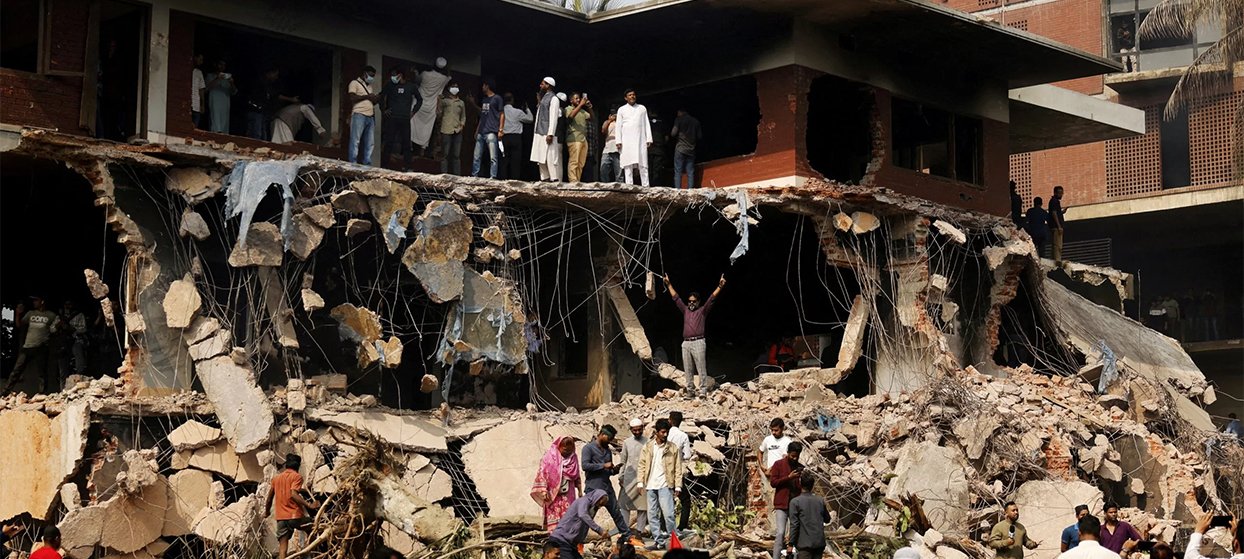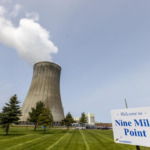Tuesday,
February 18, 2025
Year : 2, Issue: 25
By Moudud Ahmmed Sujan
Six months after a mass uprising toppled former Bangladesh Prime Minister Sheikh Hasina, a mob set the house of her late father and the country’s independence hero, Sheikh Mujibur Rahman, on fire on Wednesday night.
Along with Rahman’s Dhanmondi 32 residence, protesters also set the homes of exiled leaders of Hasina’s party, the Awami League, on fire.
The mob gathered after Hasina delivered a fiery online speech on Wednesday evening from exile in India, in which she called on her supporters to stand against the interim government led by Nobel laureate, Muhammad Yunus.
The Dhanmondi 32 house was also attacked during the July-August protests against Hasina that culminated in her removal after 15 years of rule. The protests, led largely by students and young people, began over a controversial government job quota system and transformed into nationwide unrest following a harsh crackdown by authorities, where at least 834 people were killed and 20,000 were injured in clashes with the police.
Who was Sheikh Mujibur Rahman, and what does the Dhanmondi 32 residence signify?
Hasina’s late father, Sheikh Mujibur Rahman – widely known as “Bangabandhu” (Friend of Bengal) and “Mujib” – led the nation’s liberation struggle against Pakistan that led to its independence in 1971.
As the new nation’s first president and later prime minister, Rahman’s leadership shaped the country’s early years. On January 24, 1975, he introduced a controversial one-party state system, known as Bangladesh Krishak Sramik Awami League (BaKSAL), which eliminated political opposition. This system gave the state complete control over the media; merged state, government, and party functions; and required military personnel, police, judges and civil servants to become party members.
On August 15, 1975, Mujib and all other members of his family, except Hasina and her younger sister, Sheikh Rehana, were assassinated during a military coup at his residence on the Dhanmondi 32 road in Dhaka. At the time, Hasina and her sister, Rehana, were in Germany.
Hasina’s Awami League eventually came to power, defeating the incumbent Bangladesh Nationalist Party government of Begum Khaleda Zia.
The house held great significance within Bangladesh’s independence movement, and many global leaders met with Rahman in this house until his assassination.
What triggered the recent attacks?
Protesters view Rahman’s house and other Awami League member properties as symbols of what they describe as years of authoritarian rule, corruption and suppression of opposition voices.
On Tuesday, after BBC Bangla reported that the deposed prime minister would deliver an address in a virtual event on Wednesday night, leaders of the Students Against Discrimination movement, a group at the forefront of the campaign against Hasina last year, accused India of “waging war” against the people of Bangladesh.
At 6:30pm (12:30 GMT) on Wednesday, the student group’s leader, Hasnat Abdullah, wrote on Facebook: “Tonight, Bangladesh will be freed from the shrine of fascism.”
In response, police heightened security in the Dhanmondi 32 area.
What happened to Hasina’s family’s house?
By early evening on Wednesday 5 February During Sheikh Hasina’s live speech on the Awami League’s official Facebook page and on X, she accused the interim government of unlawfully seizing power and called for resistance.
Protesters, many affiliated with the Students Against Discrimination movement, reacted with fury, carrying sticks, hammers and other tools and storming the house before setting it alight. Others brought a crane and excavator to demolish the building.
As soon as the excavator began demolishing, thousands of protesters erupted in cheers. They were also chanting slogans: “Smash the fascist stronghold, tear it down! Delhi or Dhaka? Dhaka, Dhaka! In Abu Sayeed’s Bengal, there’s no place for Hindutva.”
“This house is a symbol of fascism, and the fascist Hasina is trying to destabilise our country from exile. We will not leave any trace of fascism intact,” Sayed Ahmed, one of the protesters, told Al Jazeera.
There was a mixed reaction from onlookers.
Which other buildings were targeted?
Similar incidents have taken place in at least 19 other cities across the country since Wednesday night, according to a report by the Prothom Alo newspaper.
Those include the demolition of the Awami League offices in the eastern district of Cumilla and the central district of Tangail, the residences of several key exiled leaders in Khulna, Noakhali and Kushtia districts, and the destruction of murals of Rahman in various public establishments in Sylhet and Rangpur.
How have the government and political figures responded?
In a statement to the media, the interim government called the vandalism at the house “regrettable” but attributed it to “public outrage” over Hasina’s speech from India about the July uprising.
It accused Hasina of insulting the uprising’s “martyrs” and inciting instability.
“Her words have reopened the wounds of the July massacre, leading to the backlash” at Dhanmondi 32, read a statement issued on Thursday afternoon by the office of the interim leader, Yunus.
“The government urges India not to allow its territory to be used for destabilising Bangladesh,” it said. Once Bangladesh’s most powerful political force, the Awami League now faces widespread hostility
Source: Al jazeera







